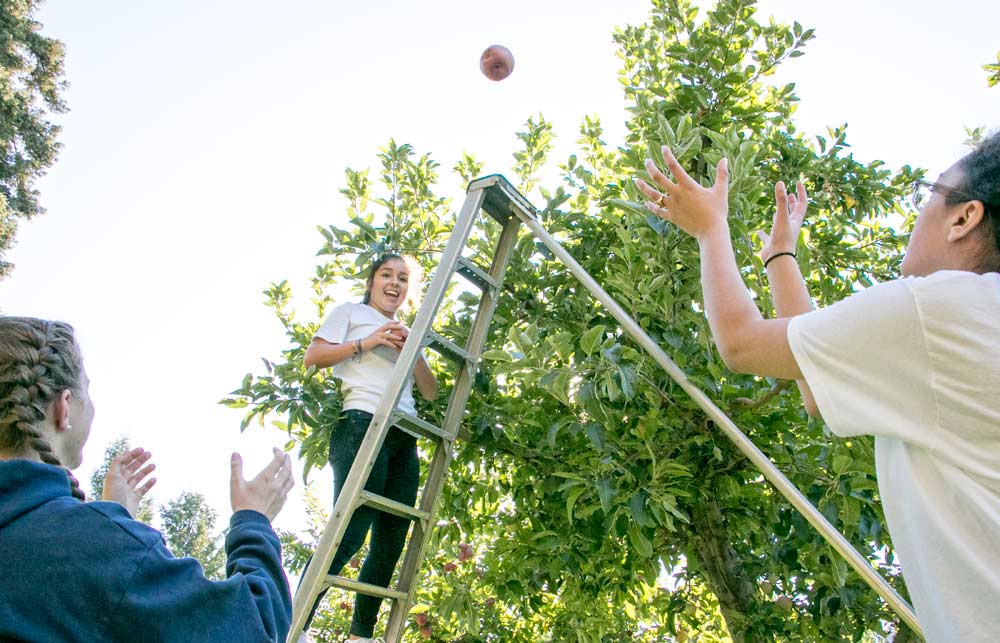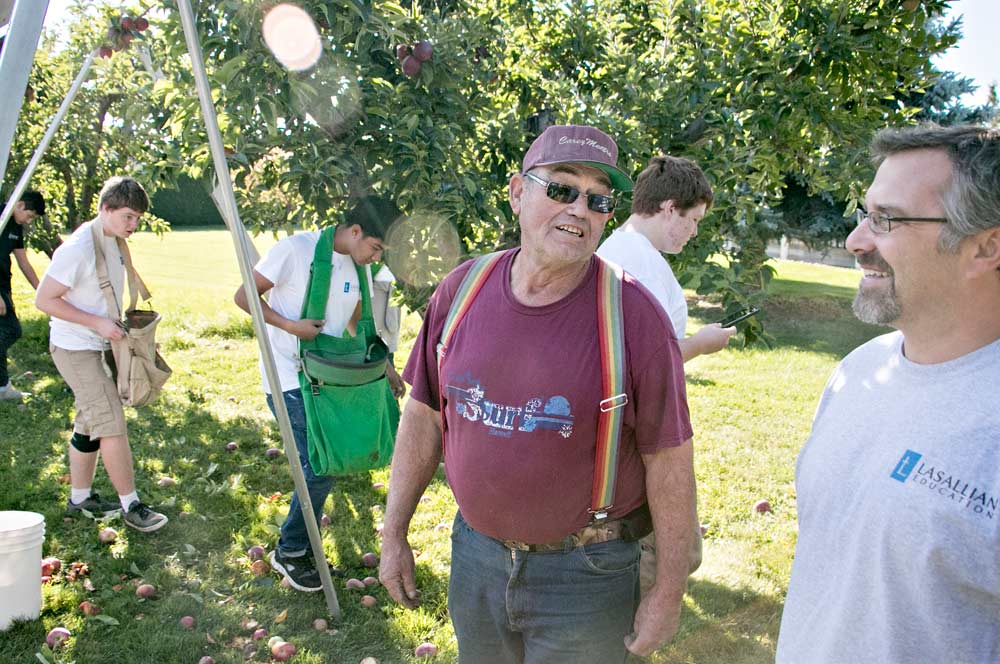
Destiney Lopez tosses apples to her LaSalle High School classmates Ellie Richardson, left, and Patience Goodin as the students harvest a Yakima, Washington, orchard’s crop of Red Delicious in September. The apples were bound for Northwest Harvest, a Washington state nonprofit food relief agency. (Ross Courtney/Good Fruit Grower)
If not for the giggling teenagers volunteering on behalf of Washington’s food banks, fourth-generation orchardist Rick Alderson might have by now cut down the last 88 trees of his family’s apple orchard that once covered 30 acres.
Each year, about 100 students from LaSalle High School in Yakima, Washington, pick his Red Delicious apples and donate them to Northwest Harvest, a nonprofit relief agency that supplies food banks across the state.
“Get back to work,” Alderson, 69, said in mock-gruffness as the students wrapped up a water break. “Enough of this playing around.”
Orchardists both large and small contribute to food banks and hunger relief agencies throughout the United States, and though the work of teenagers at orchards like Alderson’s elicit smiles and sometimes media coverage, the bulk of fresh fruit donations comes from the Walmarts of the world, large retailers.
Packing houses contribute their share, too.
Food organizations appreciate donations in all forms. Healthy, perishable produce is a hot commodity in their world and most want more of it. But contributions go the farthest when brought in a well-organized, communicated and clean manner.
For example, don’t show up unannounced at the local soup kitchen with 20 bins of ripe peaches. Most likely, the facility doesn’t have the refrigeration space.
“Basically having a relationship is the best thing to do,” said Peter Ricardo, product donations manager for the Food Bank of Central New York in Syracuse, a warehouse member of the national Feeding America network.
If you’re going to donate fruit, he advised, communicate in advance, anticipate periods of high volume and set aside space for some cosmetically imperfect fruit.
Public relations battle
No doubt, donating fruit makes a farmer and the entire industry look good in the public eye. But it can also look bad.
In May 2015, the apple industry received some brief but vocal criticism when packing companies were accused of “dumping” $95 million worth of fruit because labor strife at West Coast ports bogged down export channels. It wasn’t true.
The industry missed out on $95 million worth of export sales opportunities due to the port slowdown, according to an estimate by the Northwest Horticultural Council, a nonprofit that represents the fruit industry in international trade.
Shippers rerouted some of the 2014-2015 season’s record volume to domestic markets and processors when they could, and discarded only a portion as cattle feed, compost or trash.
Meanwhile, the 140 million-box crop was so huge warehouses were running out of their own controlled-atmosphere and cold storage, not to mention bins for the next year’s harvest, said Todd Fryhover, president of the Washington Apple Commission.
Besides, growers and shippers did give away a lot of fruit to food banks, just like they do every year. Food banks with space concerns sometimes have to turn down perishable donations. Some packers even donate to disaster relief efforts after hurricanes or earthquakes in far-flung places, Fryhover said.
A little terminology

Fourth-generation orchardist Rick Alderson, center in red, said the teenagers’ annual visit has allowed him to keep what remains of his family’s orchard even though he retired from commercial farming years ago. At 69, he wouldn’t be able to pick the apples himself. Here, he talks with math teacher Rick Maib. (Ross Courtney/Good Fruit Grower)
Most local food banks or pantries are supplied by a regional or national relief agency that operates warehouses, much like a retail chain operates distribution centers to supply its stores.
Refrigerated space at the local level is usually the limiting factor, not the capacity of regional warehouses nor the generosity of farmers, said Michael Rollinger, Northwest Harvest operations manager at the Yakima warehouse.
Each year, the agency collects 34 million pounds of food and distributes to 375 food banks and meal programs in Washington. The agency receives no federal or state funding. In the Yakima region, 70 percent of the donations are fresh fruits and vegetables.
He encourages growers to call his organization before trying to donate. The agency has agricultural specialists who help arrange pickups and dropoffs. Volunteers at their warehouses will repack the fruit into 30-pound boxes and the agency also has a fleet of its own trucks and bins.
“Sometimes, maybe we can help them,” said Rollinger, a former orchardist.
For example, each year Northwest Harvest provides cardboard bins and smaller boxes to third-generation orchardists Joy and Rodney Heit, who donate fruit from 60 Bosc and Asian pear trees at their Yakima Valley orchard. They pick it themselves, and this year, Northwest Harvest picked up two bins of Boscs while the couple hauled about 50 boxes of Asians in their own pickup.
The Heits farm about 8 acres of cherries and Bartletts commercially but have too few Boscs and Asians to bother with a warehouse, even though they are tasty, Joy said. So they have donated them for the past 20 years. “We just don’t want them to go to waste.”
Paying for donations?
Occasionally, food banks sometimes pay growers or shippers a little actual money for donations to offset the cost of labor and trucking. “(The fruit is) worth a lot more than that, but that’s better than a poke in the eye,” Ricardo said in Syracuse. For some of his growers, it makes the difference between donating or not.
Ricardo suggests growers consider paying their own work crews to harvest cosmetically blemished fruit, just for efficiency. One year, he organized a volunteer picking crew. “I got three or four bins and a lot of nice articles in the paper,” he said. The next week, the grower kept his crews around for an extra day and donated 12 bins in about four hours. The agency paid $200 for the fruit, money well spent, Ricardo said.
In Michigan, a state Department of Agriculture grant helps all seven Michigan food relief warehouses procure No. 2 fresh produce. Meanwhile, food banks contract with specific farmers each year to buy fruit at a price competitive with processing, with a state food bank association covering half the cost, said Katie Auwers, director of food acquisition for Feeding America West Michigan.
But Auwers also has plenty of growers who donate at no cost, sometimes routinely. About 61 percent of her fresh produce comes in that way. One Grand Rapids area farmer delivers a load of fresh apples every two weeks. The food bank provides him with cardboard bins early in the season and then backhauls the fruit after a regular distribution route.
Alderson
Back in Yakima, Washington, Alderson prefers the feel-good volunteer method, where working with the teenagers is half the fun, he said.
He has been donating to Northwest Harvest for about 12 years, when he realized his older varieties would never again make commercial farming worth it and the city of Yakima grew up around him. His four adult children have other careers, and he never encouraged them to farm.
For a few years, a nearby packing company hired a crew to pick the donated fruit. Then Northwest Harvest attempted to round up weekend volunteers, but it rained one year leaving him to harvest almost all that fruit by himself. About five years ago, he started working with the students.
As a “hobby” — his word — he still enjoys maintaining his backyard trees. Donating his fruit allows him to keep farming, without worrying about having a picture perfect product or the latest harvest techniques.
Though he gives the La Salle students ladders and instructions, many pick by climbing the trees and tossing the fruit down to their friends. Other perch on classmates’ shoulders. Still others put their vertical leaps to the test. Laughter fills the orchard. Alderson just shrugs and wonders what his father would think.
“He is probably rolling over in his grave.” •
Editor’s note: Since the publication of this story, Good Fruit Grower has learned of another option that would help very small-acreage growers find food banks and pantries to accept their fruit.
AmpleHarvest.org is a New Jersey non-profit designed to connect gardeners looking to donate with food banks, but some small production farmers use it, too, said Gary Oppenheimer, founder and executive director. He was named a CNN Hero for his work with the group, which operates in 50 states, and delivered a TED Talk in 2014 about his efforts.
To use AmpleHarvest.org, click “Find a Pantry,” type in your zip code and your will get a directory of nearby pantries.
Donating tips

LaSalle High School students harvest Red Delicious apples for Northwest Harvest, a nonprofit food relief agency in September in a Yakima, Washington, orchard. (Ross Courtney/Good Fruit Grower)
Interested in donating fruit to hunger relief? Here are a few tips from food bank and relief agency operators.
—Make a phone call first. Don’t just show up with a load of apples.
—Try to anticipate when prices will start to fall as you move through harvest. That’s a good time to plan for trucks and extra bins for your donations.
—Donate in cardboard boxes that do not have to be returned, if possible.
—Many food banks have their own trucks and bins. Ask about them before loading your own.
—If you need to donate in bins, make it clear to the food agency how quickly you would like those bins returned.
—Consider paying a crew to harvest for donation. Yes, it costs money, but you will be able to donate a lot more fruit a lot faster than by relying on volunteers.
—Ask about reimbursement for your donated fruit. Yes, the idea is to donate, but many food organizations have resources that allow them to pay a little money to donors, not to purchase the fruit itself but to help offset the cost of picking, packing and hauling. Prices are usually negotiated on a case by case basis, so it might pay to compare them to juicer prices.
—Know the schedule of the local food pantry. They’re not necessarily staffed every day, but even large relief organizations may direct small donations of fruit directly to a local food bank and help you schedule a delivery.
Food banks will take visually blemished fruit, such as russeted or limb scarred, but donated fruit still must be edible and healthy. They can’t give away overripe fruit either.
“I typically tell donors as a general rule of thumb, ‘If you would serve the food at your home, we can use it,’” said Katie Auwers, director of food acquisition for Feeding America West Michigan.
Communicate the storage needs of your donated fruit to the food banks. The operators may need a reminder to refrigerate.
Feeding America operates a web portal that plays matchmaker between food banks and donors. Northwest Harvest in Washington is piloting a similar web program in more populated western Washington, though most of the state’s fruit is grown in the central part of the state.
– by Ross Courtney






Leave A Comment